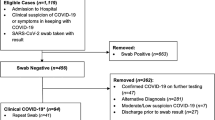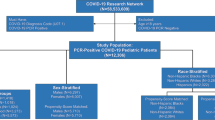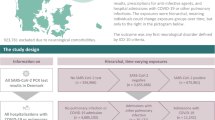Abstract
Post-acute COVID-19 causes long term sequalae in adults. This is less well described in children. We performed clinical assessments on a large cohort of children and young people admitted with a positive SARS-CoV-2 RNA swab. We assessed for symptoms of post-acute COVID-19 syndrome after 4 weeks or more. We found that most (85%) of children made a full recovery following SARS-CoV-2 infection. A small number had symptoms which lasted for more than 4 weeks, most of which had resolved at 3 months. Symptoms included dry cough, fatigue and headache. One patient suffered from anosmia. We conclude that most children and young people do not suffer from past-acute COVID-19 syndrome, and make a full recovery from infection.
Similar content being viewed by others
Introduction
Most of our current insights into the long term sequelae of COVID-19 come from adults who have recovered from symptomatic acute SARS-CoV-2 infection often with multiple organ involvement1. Children rarely have this typical acute presentation. However, symptomatic acute infection may not be a necessary precursor of the late sequelae of SARS-CoV-2 infection2. Post-acute COVID-19 has been defined as symptoms persisting or sequelae developing 4 weeks beyond the initial infection2. Recent data from the office of National Statistics in the UK suggest late symptoms occur in children and young people (CYP). We previously reported on children admitted to our hospital with SARS-CoV-2 RNA positivity during the first and second COVID-19 waves in in the UK3,4. We aimed to explore whether any of these children might have late symptoms in common with post-acute COVID-19 syndrome in adults1.
Methods
The subjects were CYP up to 18 years of age with SARS-CoV-2 RNA positivity who were admitted between 1 March 2020 and 19 January 2021 to King’s College Hospital3,4. None of the children included had PIMS-TS.
We assessed symptoms associated with post-acute COVID-19 syndrome, defined as symptoms persisting for 4 weeks or longer1. The CYP were aged 18 years or younger admitted between 1 March 2020 and 19 January 2021 to King’s College Hospital with positive SARS-CoV-2 RNA positivity.
The assessment was performed using a standardised clinical proforma (Appendix 1) over the telephone. The telephone review was made by Paediatric Respiratory consultants in March 2021 and therefore from 3–12 months after the admission.
Methods were performed in accordance to the guidelines and regulations of the trust.
This was a prospective observational cohort study. We entered the results of the assessments into an excel database, and analysed the difference between those with and without longer lasting symptoms and the severity of their initial presentation using the Chi squared test or fishers exact test. A significance of p < 0.05 was deemed significant.
Ethics approval
Approved from the ethics committee of King’s College as a service evaluation project. Methods and protocols were approved by King’s College audit committee as a clinical audit. Parents/guardian’s of children gave full informed consent to perform the assessment at the time of being assessed.
Results
A total of 88 CYP were admitted with a range of conditions. 30 (34%) were infants, 15 (17%) were of preschool, 12 (13.5%) of primary and 31 (35.5%) of secondary school age. 54 (61%) were male, 43 (49%) had an underlying co-morbidity. Acute disease severity was classified according to modified World Health Organisation classifications2. 24/88 (27%) were asymptomatic or had incidental findings and 42/88 (48%) mild, 11/88 (12.5%) moderate, 5/88 (5.5%) severe and 6/88 (7%) critical disease. We were unable to contact 17/88 (19%) at the time of the survey.
There were 71 patients available for follow up, 42/71 (59%) were male and the mean age 6.7 years (range; 11 days–17 years). Most (60/71, 85%) patients had made a complete recovery. A small proportion, namely 11/71 (15%) had symptoms beyond 4 weeks of discharge (Tables 1 and 2). These symptoms had resolved in 1–3 months in 5/11 (45%) (Table 1). Four of these 5 patients had an acute respiratory presentation and the fifth had a history of asthma making it difficult to attribute any persistence of symptoms confidently to COVID-19. Most of the more prolonged symptoms in the other patients were similarly unlikely to be due to COVID-19 and some of these patients were under investigation for a specific cause.
There was no association between severity of presentation and probability of more persistent symptoms. The most common prolonged symptom was a dry cough but it was seen in only 5/71 (7%) patients. This has been well described in both paediatric and adult cohorts5,6. Shortness of breath was seen in 4/71 (6%), fatigue in 3/71(4%) and headaches in 2/71 (3%). One patient (1.4%) suffered from anosmia. None of the 11 symptomatic patients had any symptoms that limited their daily activities like eating, drinking or getting dressed. All the children who were at school or nursery before the hospitalisation, had returned to education.
Discussion
We report the longer term effects of children hospitalised with COVID-19 infection. We have demonstrated that most children make a full recovery from the infection and do not suffer from post-acute COVID-19. A small proportion of children had on-going symptoms post 4 weeks of discharge but then recovered within 3 months. These results are reassuring for children, and underline the fact that children are less likely to be adversely affected by COVID-19 infection.
There was a very small proportion of children who had on going effects, but it is difficult to know if some of the symptoms are directly attributable to the COVID-19 infection, and some effects may be incidental. We do report a post COVID cough, and this seemed to be a consistent finding, however effected only a small proportion of patients. This has been described in adult post-acute COVID infection5 and more recently in children6. In our cohort of patients most children did recover from this within 3 months. This cough was the main symptom in the majority of the patients and this could be a post-infectious hyper-reactive airway syndrome seen in children following other viral infections. Interestingly, a prospective single centre study performed in Israel, showed that children seen in a designated multi-disciplinary clinic for long COVID revealed impairment in lung function testing in 45% of patients with cardiorespiratory symptoms, however there was not a control group, and the abnormalities comprised of mild obstructive patterns, with more than half exhibiting bronchodilator reversibility7.
Our findings are in contrast to a review of Dutch patients, whereby a large number of children were identified as having long COVID8, however, in contrast to our report this study included patients with suspected COVID, and not all patients had a positive PCR test. Our cohort differs as all of our children were in hospital at the time of testing positive for SARS-CoV-2. There have been further studies which have showed possibility of long COVID. A recent narrative review of 14 paediatric studies, it was highlighted that many of the studies included patients who did not necessarily have a positive PCR test, rather self reported COVID-19 infection, and thus could include problems from other viruses9. The review found only 4 studies with control groups. They found that there were major limitations in all of the studies, which probably accounts for the wide prevalence of COVID 19 between the studies of between 4 to 66%9. The review concluded the evidence for long COVID in CYP to be limited, with the absence of a control group meaning that it is difficult to differentiate symptoms attributable to COVID-19 vs those related to the pandemic in general. The review did however feel further studies in this group are important, to help guide us as to whether immunisation in this group could be necessary to prevent long COVID.
This follow up study of a cohort of CYP hospitalised with COVID-19, and demonstrates that the majority of CYP (85%) did not encounter any long-term sequelae. Assuming this data can be generalised globally, it would help to understand the natural history of this virus in CYP and enable prioritisation of follow-up care.
Conclusion
We conclude from our assessments, that most children admitted with COIVD-19 make a full recovery. There are very small proportion of children who had longer lasting effects but these could be effects seen commonly following other viral illnesses.
Data availability
We have available data as needed. The datasets used and/or analysed during the current study are available from the corresponding author on reasonable request. All the patients with prolonged symptoms are described in the tables.
References
Nalbandian, A. et al. Post-acute COVID-19 syndrome. Nat. Med. 27(4), 601–615 (2021).
Datta, S. D. et al. A proposed framework and timeline of the spectrum of disease due to SARS-CoV-2 infection: Illness beyond acute infection and public health implications. J. Am. Med. Assoc. 324, 2251–2252 (2020).
Harman, K. et al. Ethnicity and COVID-19 in children with comorbidities. Lancet Child Adolesc. Health 4(7), e24–e25. https://doi.org/10.1016/S2352-4642(20)30167-X (2020).
Brookman, S. et al. Effect of the new SARS-CoV-2 variant B.1.1.7 on children and young people. Lancet Child Adolesc. Health 5(4), e9–e10 (2021).
Song, W. J. et al. Confronting COVID-19-associated cough and the post-COVID syndrome: Role of viral neurotropism, neuroinflammation, and neuroimmune responses. Lancet Respir. Med. 12, 533–544 (2021).
Say, D. et al. Post-acute COVID-19 outcomes in children with mild asymptomatic disease. Lancet Child Adolesc. Health. https://doi.org/10.1016/S2352-4642(21)00124-3 (2021).
Ashkenazi-Hoffnung, L. et al. Long COVID in children: Observations from a designated pediatric clinic. Pediatr. Infect. Dis. J. 40(12), e509–e511 (2021).
Brackel, C. L. et al. Pediatric long-COVID: An overlooked phenomenon. Pediatr. Pulmonol. https://doi.org/10.1002/ppul.25521 (2021).
Zimmerman, P., Pittet, L. & Curtis, N. How common is long COVID in children and adolescents?. Pediatr. Infect. Dis. J. 40, e482–e487 (2021).
Acknowledgements
We thank the patients and their families, the Paediatric Respiratory Unit, the Paediatric Intensive Care Unit, the General Paediatrics teams, the Business Intelligence Unit, and the Department of Paediatrics and Child Health at King’s College Hospital.
Author information
Authors and Affiliations
Contributions
C.J.B. designed the proforma, performed the clinical assessments and wrote the manuscript. E.K., J.C., G.R. and A.G. all performed the clinical assessments. All authors reviewed and contributed to the manuscript. A.G. designed the project and performed final review of the manuscript.
Corresponding author
Ethics declarations
Competing interests
The authors declare no competing interests.
Additional information
Publisher's note
Springer Nature remains neutral with regard to jurisdictional claims in published maps and institutional affiliations.
Supplementary Information
Rights and permissions
Open Access This article is licensed under a Creative Commons Attribution 4.0 International License, which permits use, sharing, adaptation, distribution and reproduction in any medium or format, as long as you give appropriate credit to the original author(s) and the source, provide a link to the Creative Commons licence, and indicate if changes were made. The images or other third party material in this article are included in the article's Creative Commons licence, unless indicated otherwise in a credit line to the material. If material is not included in the article's Creative Commons licence and your intended use is not permitted by statutory regulation or exceeds the permitted use, you will need to obtain permission directly from the copyright holder. To view a copy of this licence, visit http://creativecommons.org/licenses/by/4.0/.
About this article
Cite this article
Bossley, C.J., Kavaliunaite, E., Harman, K. et al. Post-acute COVID-19 outcomes in children requiring hospitalisation. Sci Rep 12, 8208 (2022). https://doi.org/10.1038/s41598-022-12415-x
Received:
Accepted:
Published:
DOI: https://doi.org/10.1038/s41598-022-12415-x
Comments
By submitting a comment you agree to abide by our Terms and Community Guidelines. If you find something abusive or that does not comply with our terms or guidelines please flag it as inappropriate.



